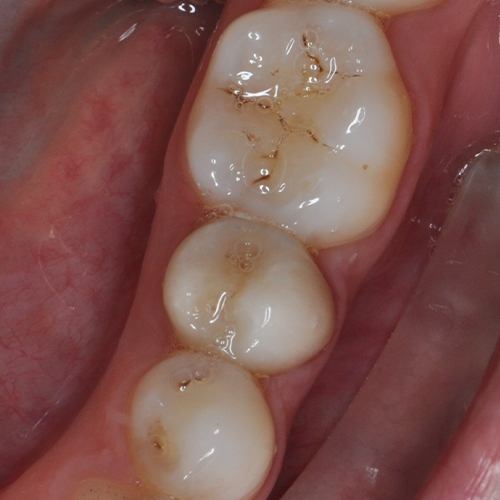
At Mouth Dental our Dental Crowns are made from durable, high-quality material that also looks natural and indistinguishable when restoring your smile.
CROWNS
Dental crowns are also known as caps that resemble natural teeth that can fit over damaged and discoloured teeth, as well as dental implants. They restore the shape, size, strength, colour, and appearance of a tooth. When fixed into place, a typical crown completely encases the entire visible portion of a tooth from the gum line and above. Dental crowns at Mouth are usually made from ceramics such as emax or zirconia, porcelain-fused-to-metal and in some situations, gold.
Crowns are often recommended after root canal treatment on the back chewing teeth to reduce the risk of the tooth splitting. Front teeth do not always need a crown after root canal treatment, it depends on the amount of remaining tooth structure, appearance and risk of fracture.



ONLAYS
Onlays are similar to crowns, like a partial crown. Onlays are recommended to restore a tooth when there is a large existing filling with a broken cusp or a has high risk of cusp fracture. Onlays are partial coverage and require less removal of tooth structure.
Onlays are the treatment of choice when preservation of the remaining tooth structure and the nerve is the main aim. Onlays are only possible for the back chewing teeth, the disadvantage is that sometimes the join from onlay to tooth structure is visible.

MEET YOUR DENTIST FOR CROWNS/ ONLAYS AT MOUTH NINE ELMS
Why is a dental crown needed?
Dental crowns can correct numerous damage-related, colour-related, and shape-related teeth issues. Composite resin bonding can;
- A dental crown caps a damaged, broken, or worn-down tooth to give it full structure.
- It can protect a weakened tooth from breaking or hold together a cracked one in place. Tooth decay can make teeth fragile and easy to chip.
- To protect heavily restored teeth from breaking.
- When there isn’t much tooth remaining to support a filling, a crown can cover and support the tooth with the oversized filling.
- After tooth canal treatment, having a crown fitted to the tooth improves tooth survival rates.
- A dental implant needs a permanent crown to sit on top in the place of the missing tooth.
- Dental crowns hold a dental bridge in place.
- To discreetly cap badly discoloured teeth and misshapen teeth to enhance aesthetics.
- Crowns can also cover extremely sensitive teeth to help you take in food and drink without causing discomfort.
What types of crowns are available?
There are different types of crowns. Some are temporary crowns, and others are permanent crowns. Onlays and 3/4 crowns do not offer full coverage and are used when some of the underlying solid tooth structure still remains. Temporary crowns are put in until your permanent crown is ready.

Dental crown procedure step by step
STEP 1
The old existing filling on the badly broken down tooth is sometimes changed to a fresh new one to ensure the base of the new crown/ onlay is built on new and strong foundations. The tooth is then trimmed to create space for a new crown/ onlay.
A digital scan or impression is taken to send to our affiliated dental laboratories to create a crown/ onlay. Photos are sometimes taken to ensure the colour and characteristics of your crown matches your own teeth as best as possible.
A temporary crown/ onlay is cemented on.
STEP 2
Book your virtual consultation
Begin your personalised smile transformation at Mouth Dental.
Book your free consultation with us now and let’s discuss treatment options to help you get that perfect smile!

Frequently asked questions
HOW LONG DO CROWNS/ ONLAYS LAST?
Depending on the amount of remaining tooth structure, a crown/ onlay can last around 8-10 years or longer. If they require replacement, if can be because the underlying tooth structure is weak and may have broken, the gumline is visible and is unsightly, there is decay around the crown margins or the crown has fallen off and is lost and cannot be recemented.
HOW DO I CARE FOR MY TEMPORARY CROWN/ ONLAY?
It is important to keep the edges of the temporary crown/ onlay clean to avoid the gums bleeding during the final fit appointment. It is best not to floss temporarily as it may dislodge the temporary crown/ onlay. If you do need to floss, then slide the floss down in between the teeth and pull the floss out from the side instead of upwards. Turmeric in your diet may stain your temporary crown bright yellow. We suggest purchasing Dentek Temparin Max to cover your tooth just in case the temporary comes away before the fit appointment.
HOW DO I CARE FOR MY PERMANENT CROWN/ ONLAY?
Exactly the same as your normal teeth.
CAN I REPLACE AN OLD CROWN?
Yes we carefully remove the crown and take a new scan or impression.
WHAT SHOULD I DO IF MY CROWN/ ONLAY HAS FALLEN OFF?
Keep it safe and clean. Contact us and bring the crown/ onlay to your appointment. Do not delay as your adjacent and opposite teeth can move into the space, causing difficulties in reseating the crown/ onlay.
WILL MY CROWN LOOK LIKE A NATURAL TOOTH?
We will endeavour to make your tooth coloured crown match your natural teeth as much as possible. For crowns on the front teeth, we will take photos and sometimes we may ask you to make a trip to the laboratory so that the dental technician making your crown can verify the shade and shape.
